Predicting the Value of Farmersí
Almanacs
by Bob Brooke
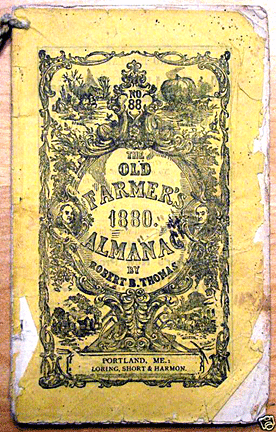 QUESTION: QUESTION:
I happen to come into about 20 old
and different Farmerís Almanacs ranging in issue dates from 1867 to
1930. I haven't been able to find any information on them. What can you
tell me about them? Do they have any value?
Thanks,
Frank
__________________________________________________________
ANSWER:
Before looking at how to
determine the value of your almanacs, itís important to note
that over the last two centuries there have been several
almanacs with the name ďFarmerísĒ in their titles.
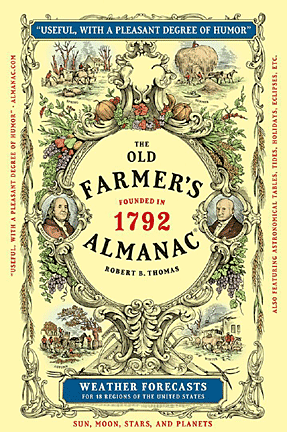 By
the late 18th century, many almanacs included the term
ďFarmerísĒ in their titles because the young nation was
mostly one of farmers who wanted to know what the weather
would be like for the coming year, so they would know when
to plant and harvest their crops. Accurate weather
prediction meant the difference between survival and
starvation. By
the late 18th century, many almanacs included the term
ďFarmerísĒ in their titles because the young nation was
mostly one of farmers who wanted to know what the weather
would be like for the coming year, so they would know when
to plant and harvest their crops. Accurate weather
prediction meant the difference between survival and
starvation.
Of the two publications known today as farmerís almanacs,
the Old Farmer's Almanac, originally published in 1792 and
still published every September, is the most widely known.
Begun by Robert Thomas, itís first editor, the Old Farmer's
Almanac grew from a circulation of 3,000 copies to over
9,000 in just three years. The cost was only nine cents.
Thomas added the word "Old" to the title of his almanac in
1832, then removed it three years later.
Since Thomasí almanac format wasn't unique, perhaps his
weather predictions were more accurate. Based on his
observations, Thomas devised a complex series of natural
cycles to create a secret weather forecasting formula,
resulting in unusually accurate forecasts.
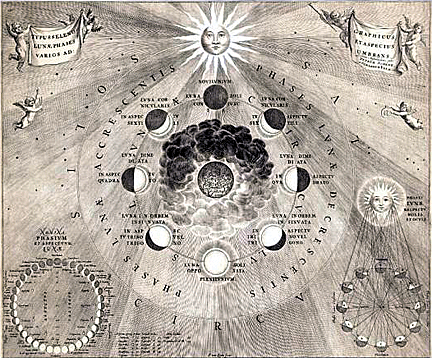 An
almanac, by definition, records and predicts astronomical
eventsóthe rising and setting of the Sun, for instance),
tides, weather, and other phenomena with respect to time. So
what made The Old Farmerís Almanac different from the
others? Since his format wasnít novel, we can only surmise
that Thomasís astronomical and weather predictions were more
accurate, the advice more useful, and the features more
entertaining. An
almanac, by definition, records and predicts astronomical
eventsóthe rising and setting of the Sun, for instance),
tides, weather, and other phenomena with respect to time. So
what made The Old Farmerís Almanac different from the
others? Since his format wasnít novel, we can only surmise
that Thomasís astronomical and weather predictions were more
accurate, the advice more useful, and the features more
entertaining.
Based on his observations, Thomas used a complex series of
natural cycles to devise a secret weather forecasting
formula, which brought uncannily accurate results,
traditionally said to be 80 percent accurate.
John H. Jenks bought the publication after Thomas died, then
put the word ďOldĒ back in the title in 1848. Three years
later, Jenks hired Henry Nichols to create the Almanacís
trademark four-seasons cover that has remained with the
periodical ever since.
In 1861, Charles L. Flint became editor and focused the
Almanacís content on farming to provide his growing
readership with information they could use. By 1900, the Old
Farmerís Almanac had yet another editor, Horace Ware, who
aimed the publication beyond farmers to a more general
readership by using features on nature and modern life
instead of farming..
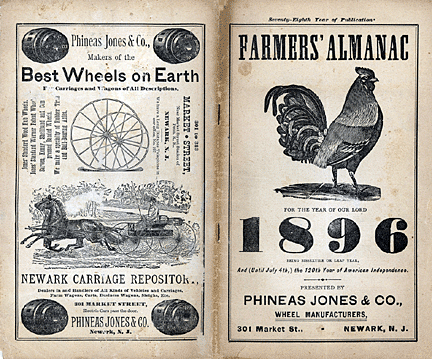
After surviving the World War I and the Depression, the Old
Farmerís Almanac entered a new era under the leadership of
Roger Scaife who became editor in 1936. Its circulation had
fallen from a high of 225,000 in 1863 to just 88,000. He
mistakenly eliminated the weather forecasts, thinking that
his readers didnít need them, and almost killed the
publication.
Robb Sagendorph, owner of Yankee Magazine, bought the Old
Farmer's Almanac in 1939 and moved it to Dublin, New
Hampshire. He reinstated Thomasí original format and style
the readership of the publication began to grow once again.
In 1942, a German spy was apprehended by the FBI after being
landed on Long Island, New York, by a U-boat the night
before. The impact of this event was felt all the way to
Dublin, New Hampshire, because The Old Farmerís Almanac was
found in his coat pocket. The U.S. government speculated
that the Germans were using the Almanac for weather
forecasts, which meant that the book was indirectly
supplying information to the enemy.
Fortunately, Sagendorph managed to get the government to
agree that there would be no violation of the ďCode of
Wartime Practices for the American PressĒ if the Almanac
featured weather indications rather than forecasts. It was a
close call that almost ruined the Almanacís perfect record
of continuous publication.
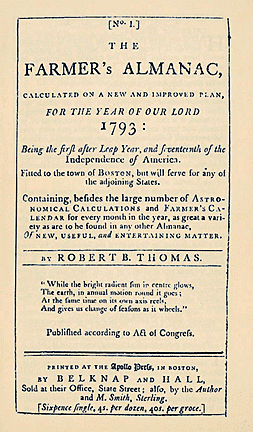 The
other publication, known simply as the Farmers' Almanac, has
been in continuous publication since 1818. David Young and
Jacob Mann founded their little publication in Morristown,
New Jersey two years after what has come to be known as ďthe
year without a summer.Ē During that year, farmers crops
suffered severely from the unusual weather, so Young and
Mann decided to create a publication which would offer them
accurate weather forecasts to prevent a disaster like that
from happening again. The
other publication, known simply as the Farmers' Almanac, has
been in continuous publication since 1818. David Young and
Jacob Mann founded their little publication in Morristown,
New Jersey two years after what has come to be known as ďthe
year without a summer.Ē During that year, farmers crops
suffered severely from the unusual weather, so Young and
Mann decided to create a publication which would offer them
accurate weather forecasts to prevent a disaster like that
from happening again.
Astronomer Samuel Hart Wright succeeded Young in 1851to
become the second of only seven editors of the publication.
Eventually, the publicationís offices moved from Morristown
to nearby Newark, New Jersey.
Ray Geiger served as the Farmersí Almanac's longest-running
editor, from 1934 until shortly before his death in 1994. In
1955, he moved production of the Farmers' Almanac from
Newark to its current headquarters in Lewiston, Maine.
Today, his son, Peter Geiger continues to publish the
Almanac.
Published by the Almanac Publishing Company, of Lewiston,
Maine, the Farmerís Almanac has become noted for its
long-range weather predictions. Its readers claim the
Almanac is 80-85 percent accurate in its predictions. But
studies comparing the actual weather with the Almanacís
predictions have shown that the predictions arenít any more
accurate than pure chance.
Although the editors of the Farmerís Almanac make
predictions as far as two years in advance, theyíre . re
highly secretive about how they go about making them, only
saying that they rely on astronomical data like the
positions of the planets, sunspot activity, and tidal
action. To put an identity to the forecasts, the editors
created a fictitious forecaster Caleb Weatherbee.
Writing to down-home farmer folk, the almanac has also
included its own special blend of advice on farming,
gardening, fishing, and cooking over the years, as well as
human-interest articles. Its editors have continually
focused on the themes of simplicity, sustainable living, and
conservation.
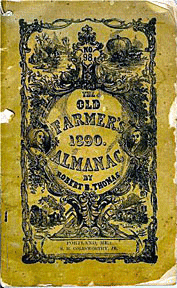 Old
copies of both the Old Farmerís Almanac and the Farmerís
Almanac abound. Since each was the farmerís best companion
and popular with even regular people for its weather
predictions, there are a lot of old copies hidden in
peopleís attics and basements. Unfortunately, these arenít
always in the best condition. And as with any other
collectible, especially paper ones, condition is of prime
importance when determining value. The earlier issues from
the 19th century, printed on paper high in rag content, are
usually in much better condition, but dampness can play a
big role in paper deterioration. But even in the best
condition, the sheer number of copies out there prevent the
value from becoming too high. Old
copies of both the Old Farmerís Almanac and the Farmerís
Almanac abound. Since each was the farmerís best companion
and popular with even regular people for its weather
predictions, there are a lot of old copies hidden in
peopleís attics and basements. Unfortunately, these arenít
always in the best condition. And as with any other
collectible, especially paper ones, condition is of prime
importance when determining value. The earlier issues from
the 19th century, printed on paper high in rag content, are
usually in much better condition, but dampness can play a
big role in paper deterioration. But even in the best
condition, the sheer number of copies out there prevent the
value from becoming too high.
The average selling price on eBay for a late 19th-century
copy of the Old Farmerís Almanac from say the 1870s is only
about $12-15. Editions from the 1920s sell for only about
$4. Abebooks.com, an online used bookseller, has an 1890
edition in fair condition priced at just $9.
And while these prices are a far cry from the publicationís
original price, these little gems are probably more fun to
read than to consider as an investment.
<
Back to Readers Ask Archives
Next Article > |
